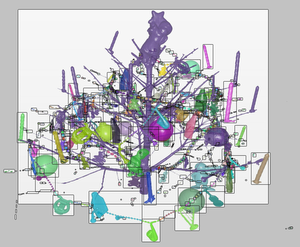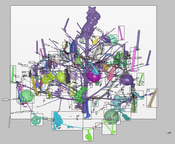Information
- Publication Type: Master Thesis
- Workgroup(s)/Project(s):
- Date: September 2015
- First Supervisor:
Abstract
Often, users of visualization applications do not have access to high performance systems for the computationally demanding visualization tasks. Rendering the visualization remotely and using a thin client (e.g. a web browser) to display the result enable the users to access the visualization even on devices that do not target graphics processing. However, the flexibility to manipulate the data set interactively suffers in thin-client configurations. This makes a meaningful interaction with data sets that contain many different objects difficult. This is especially true in in-situ visualization scenarios, where direct interaction with the data can be challenging.We solve this problem by proposing an approach that employs a deferred visualization pipeline to divide the visualization computation between a server and a client. Our thin client is built on web technologies (HTML5, JavaScript) and is integrated with the D3 library to enable interactive data-driven visualizations. An intermediate representation of objects is introduced which describes the data that is transferred from the server to the client on request. The server side carries out the computationally expensive parts of the pipeline while the client retains extensive flexibility by performing object modification tasks without requiring a re-rendering of the data.
We introduce a novel Volume Object Model as an intermediate representation for deferred visualization. This model consists of metadata and pre-rendered visualizations of each object in a data set.
In order to guarantee client-side interactivity even on large data sets, the client only receives the metadata of all objects for a pre-visualization step. By allowing the user to perform filtering using the metadata alone, the complexity of the requested visualization data can be reduced from the client side before streaming any image data. Only when the user is satisfied, the object images are requested from the server. In combination with the metadata, the final visualization can then be reconstructed from the individual images. Moreover, all objects in the visualization can be investigated and changed programmatically by the user via an integrated console.
In summary, our system allows for fully interactive object-related visualization tasks in a web browser without triggering an expensive re-rendering on the server.
Additional Files and Images
Weblinks
No further information available.BibTeX
@mastersthesis{Fruehstueck_Anna_2015_DOM,
title = "Decoupling Object Manipulation from Rendering in a Thin
Client Visualization System",
author = "Anna Fr\"{u}hst\"{u}ck",
year = "2015",
abstract = "Often, users of visualization applications do not have
access to high performance systems for the computationally
demanding visualization tasks. Rendering the visualization
remotely and using a thin client (e.g. a web browser) to
display the result enable the users to access the
visualization even on devices that do not target graphics
processing. However, the flexibility to manipulate the data
set interactively suffers in thin-client configurations.
This makes a meaningful interaction with data sets that
contain many different objects difficult. This is especially
true in in-situ visualization scenarios, where direct
interaction with the data can be challenging. We solve this
problem by proposing an approach that employs a deferred
visualization pipeline to divide the visualization
computation between a server and a client. Our thin client
is built on web technologies (HTML5, JavaScript) and is
integrated with the D3 library to enable interactive
data-driven visualizations. An intermediate representation
of objects is introduced which describes the data that is
transferred from the server to the client on request. The
server side carries out the computationally expensive parts
of the pipeline while the client retains extensive
flexibility by performing object modification tasks without
requiring a re-rendering of the data. We introduce a novel
Volume Object Model as an intermediate representation for
deferred visualization. This model consists of metadata and
pre-rendered visualizations of each object in a data set.
In order to guarantee client-side interactivity even on
large data sets, the client only receives the metadata of
all objects for a pre-visualization step. By allowing the
user to perform filtering using the metadata alone, the
complexity of the requested visualization data can be
reduced from the client side before streaming any image
data. Only when the user is satisfied, the object images are
requested from the server. In combination with the metadata,
the final visualization can then be reconstructed from the
individual images. Moreover, all objects in the
visualization can be investigated and changed
programmatically by the user via an integrated console. In
summary, our system allows for fully interactive
object-related visualization tasks in a web browser without
triggering an expensive re-rendering on the server.",
month = sep,
address = "Favoritenstrasse 9-11/E193-02, A-1040 Vienna, Austria",
school = "Institute of Computer Graphics and Algorithms, Vienna
University of Technology ",
URL = "https://www.cg.tuwien.ac.at/research/publications/2015/Fruehstueck_Anna_2015_DOM/",
}

 Poster
Poster Thesis
Thesis


